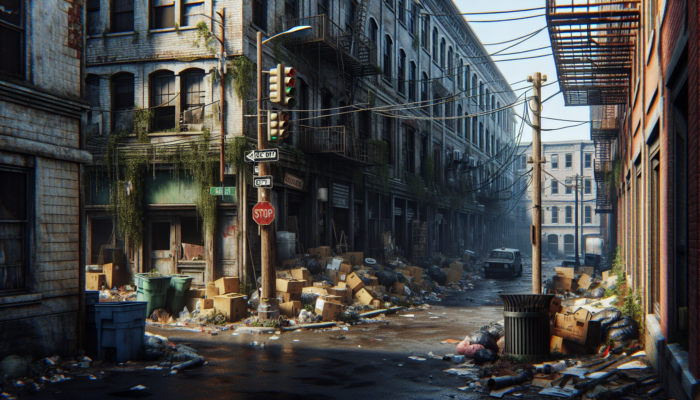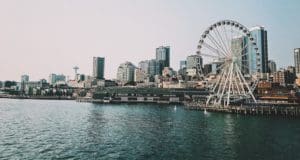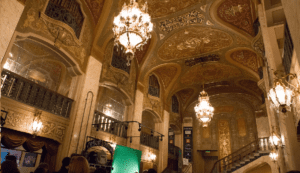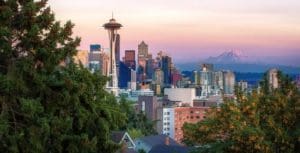![10 Areas to Avoid in Spokane, WA [TOURIST SAFETY GUIDE]](https://www.exploreist.com/wp-content/uploads/2023/12/areas-to-Avoid-in-Spokane-300x171.png)
10 Areas to Avoid in Washington, D.C. (2023) [SAFETY GUIDE]
As a seasoned traveler who has navigated many cities, Washington, D.C. stands out for its rich history and political gravitas. However, like any major city, certain areas can be less welcoming for visitors. Having experienced the capital’s diverse neighborhoods, I’ve learned that some spots are best to sidestep for a smooth visit.
Smithsonian museums and national monuments often top sightseeing lists, but knowing things to do in DC at night can offer a more rounded experience, ensuring your itinerary includes both celebrated locations and safe evening activities. This realization came quickly during my explorations, highlighting the need for a visitor’s guide to areas to avoid in Washington, D.C.
Drawing upon my encounters and local insights, I’ve compiled a list that aims to keep your D.C. adventure safe and enjoyable. Stick with us as we delve into the neighborhoods that might disrupt the otherwise memorable trip you’re seeking in the heart of America’s history.

Top Areas to Avoid in Washington, D.C.
1. Brentwood
Nestled in the Northeast quadrant of Washington, D.C., Brentwood is a neighborhood that’s historically had a bit of a reputation. While it’s been on the mend with new developments, it is still considered one of the areas to avoid in Washington, D.C., especially at night.
Visitors and residents alike should stay vigilant, keeping up with local advisories. Parts of Brentwood near Rhode Island Avenue have seen higher crime rates, so be sure to plan your route during daylight and stay aware. For those seeking a safer visit, you might want to look into recommended restaurants in the heart of Washington for a more pleasant experience.
Address: Brentwood, Washington, D.C. 20018
2. Anacostia
Anacostia, a neighborhood in Southeast Washington, D.C., bears a complex narrative, intertwining vibrant culture with challenging dynamics. Despite redevelopment efforts, certain parts remain troubled with public safety concerns, making it one of the areas to avoid in Washington, D.C., especially for those unfamiliar with the region.
For travelers exploring Washington, D.C., it’s wise to approach Anacostia with caution, particularly in less densely populated areas. Nighttime can introduce additional risks, so it’s best to visit during daylight hours, engaging with the community respectfully and safely.
The presence of historical landmarks and the Anacostia Arts Center highlight the area’s resilience and cultural significance. Nevertheless, stay informed by monitoring recent crime reports and local advice before venturing into Anacostia, to appreciate its offerings while ensuring your safety.
Address: 1901 Fort Pl SE, Washington, DC
3. Deanwood
Deanwood, located in Northeast Washington, D.C., reflects a community in transition with a storied past. While revitalization efforts are bringing positive change, some spots remain less secure, with certain areas gaining notoriety as high-crime areas in the District of Columbia. For those navigating the district, it’s advisable to stay cautious, especially after dark.
This area, known for its family-centric culture and deep historical roots, still grapples with safety issues in certain pockets. When planning a visit, prioritize well-trafficked streets and daylight hours. Keep abreast of local safety updates to experience Deanwood’s ongoing transformation responsibly and safely.
Address: 4501 Minnesota Ave NE, Washington, D.C. 20019
4. U Street Corridor
The U Street Corridor in Washington, D.C., once known as “Black Broadway,” is an area steeped in cultural heritage and nightlife vibrancy. It’s a hub for music, dining, and entertainment, attracting both locals and visitors alike. However, as with any bustling urban area, it sees a mix of energies and activities, which can occasionally mirror the risks found in high-crime corridors in the U.S. Capital. Visitors should remain vigilant, particularly at night, and stick to well-lit, populated paths.
Although U Street boasts a rich history and a lively atmosphere, it’s prudent for travelers to stay aware of their surroundings. Join the crowd, enjoy the scene, but maintain personal safety by keeping informed of the local happenings.
Address: 1215 U Street NW, Washington, D.C.
5. Columbia Heights
Columbia Heights, another D.C. neighborhood experiencing transformation, presents a vibrant mix of new developments and historic charm. Its diversity is celebrated, but parts of the area still confront challenges with crime, drawing attention to the importance of being aware of Washington D.C.’s no-go zones. Visitors are encouraged to stay vigilant, particularly in less busy areas and during evening hours, aligning with common urban travel sense.
The community offers an eclectic array of dining, shopping, and cultural experiences, which draw both tourists and residents. To fully enjoy the energy of Columbia Heights while prioritizing safety, remain in well-lit, populous areas and keep abreast of any local advisories.
Address: 3100 14th St NW, Washington, D.C. 20010
6. Petworth
Petworth, a historic neighborhood in Northwest D.C., has seen a resurgence with vibrant community spaces and popular eateries. With its renewed spirit, the district attracts a creative and diverse crowd, contributing to the city’s cultural tapestry. However, it’s wise to navigate Petworth with a note of caution, as certain pockets can be seen as high-risk areas around Capitol Hill, much like any growing urban area.
The area’s blend of charm and redevelopment continues to draw attention, but visitors should stay alert, particularly after dark. Engage with the neighborhood’s charm by frequenting the bustling parts of the community, and always stay informed of your surroundings to enjoy Petworth’s allure to the fullest.
Address: 829 Upshur St NW, Washington, DC
7. Shaw
Shaw, a historic neighborhood in Washington, D.C., is a tapestry of culture and history, pulsating with life from dawn until dusk. Its lively streets are lined with hip eateries, cool jazz spots, and unique boutiques, capturing the essence of urban revival. However, as an area amid transformation, Shaw can indeed be counted amongst areas to avoid in Washington, D.C. at night, when its less bustling nooks may warrant extra caution.
For a harmonious blend of experience and safety, stick to the main thoroughfares and well-populated areas within Shaw, particularly if you’re exploring after sundown. Embracing the district’s energetic atmosphere while staying street-smart allows visitors to appreciate the best of Shaw’s vibrant community spirit.
Address: 1600 7th St NW, Washington, D.C. 20001
8. Ledroit Park
LeDroit Park, a historical gem in Northwest D.C., hums with a sense of community amid its Victorian-style homes. It epitomizes architectural charm intertwined with a dynamic, evolving urban fabric. Yet, as with any city, there are Risky areas in Washington D.C., and parts of LeDroit Park should be approached with care, especially after the twilight hours.
While LeDroit Park holds its own as a neighborhood on the rise, visitors should prioritize safety by staying vigilant. Enjoy its quaint streets and pocket parks during the day, and stick to well-lit, populated paths at night. To explore LeDroit Park’s unique character, savvy travelers keep a watchful eye without missing a beat of its local heartbeat.
Address: 200 T St NW, Washington, DC
9. Stadium-Armory
Stadium-Armory, once a bustling sports hub of D.C., echoes with the cheers of games past, yet it is important to be aware that it is adjacent to some of the areas to avoid in Washington, D.C., particularly less welcoming after dark. Nestled between East Capitol Street and Independence Avenue, this neighborhood offers an unvarnished slice of city life. Its character is raw and occasionally rough-edged, demanding attentiveness from nighttime wanderers.
Visitors should navigate its streets with prudence befitting any urban sprawl teetering between renewal and neglect. By day, the spirit of community is palpable, yet after dusk, stick to well-lit streets and avoid secluded spots. Stadium-Armory’s historic vibe and connection to iconic sports lore are best appreciated with cautious exploration.
Address: 192 19th St SE, Washington, DC
10. South West
South West stands out in Washington, D.C., as an amalgamation of progress and caution for visitors. This quadrant, marked by development, also bears pockets one might wisely sidestep post-sunset, earning a reputation as one of the areas to avoid in Washington, D.C. at night. The area flaunts waterfront allure, but as night falls, it’s prudent for travelers to navigate with alert.
The streets of South West can thrum with life by day, yet certain blocks warrant extra vigilance when the sun dips. For those exploring its diverse offerings, the best bet is sticking to areas buzzing with evening activity. Concluding your day with safety in mind ensures a more pleasant experience.
Address: 1100 4th St SW, Washington, DC
Conclusion
Navigating the vibrant cityscape of Washington, D.C. can be an exhilarating experience, but it’s important to approach this urban exploration with an awareness of the areas to avoid. While much of the capital is rich with historical landmarks and bustling activity, certain neighborhoods have higher crime rates and may not be the best choice for tourists or those unfamiliar with the area. For those seeking a family-friendly hotel option in safer districts, consider exploring some of the best hotels for kids in Washington D.C. This can help to ensure their safety and enjoy all the positive experiences that D.C. has to offer.
Remember, the key to a memorable trip to Washington, D.C. is not just in the places you visit, but also in knowing where you might be better off not venturing. By keeping the guidance on areas to avoid in mind, your time in the nation’s capital can be both awe-inspiring and secure. Stay smart, stay safe, and let the rich tapestry of Washington’s safer districts paint an unforgettable experience for you!
Frequently Asked Questions
What are the most common safety concerns for visitors to Washington, D.C.?
The primary safety concerns typically include petty thefts such as pickpocketing, especially in crowded areas, along with occasional muggings or violent crimes in certain less busy and less well-lit areas, particularly at night.
Are there specific areas in Washington, D.C. that are considered particularly dangerous?
Yes, certain neighborhoods have higher crime rates and are often advised against visiting, especially at night. These neighborhoods can change over time, but historically, parts of Northeast and Southeast D.C., such as Trinidad, Anacostia, and Deanwood, have had reputations for higher crime rates. It’s always best to look up recent crime data or ask locals for updated advice.
Is it safe to use public transportation in Washington, D.C.?
Public transportation, like the Metro system, is generally safe, but it’s important to remain vigilant and aware of your surroundings, especially during off-peak hours. Avoid empty train cars and wait in well-lit areas of the platform when traveling at night.
What precautions should visitors take when exploring Washington, D.C.?
Visitors should stay in well-lit and populated areas, especially after dark. It’s advisable to keep valuables out of sight, not flash expensive electronics or jewelry, and always be aware of your surroundings. Using a map or GPS discreetly can prevent you from looking like an easy target.
Should tourists avoid Washington, D.C. altogether due to safety concerns?
No, Washington, D.C. is a vibrant city with a wealth of American cultural and historical attractions. Like any major city, it has areas that are less safe than others, but with the right precautions, tourists can have a safe and enjoyable experience. Always do your research beforehand and consider staying in well-known tourist-friendly areas.

![11 Places to Avoid in Seattle, WA [TOURIST SAFETY GUIDE]](https://www.exploreist.com/wp-content/uploads/2023/09/uh-bkq95gb8-e1694632790996-300x172.jpg)


![19 BEST Restaurants in Tacoma, Washington [2023 UPDATED]](https://www.exploreist.com/wp-content/uploads/2019/09/best-restaurants-in-tacoma-300x200.png)
